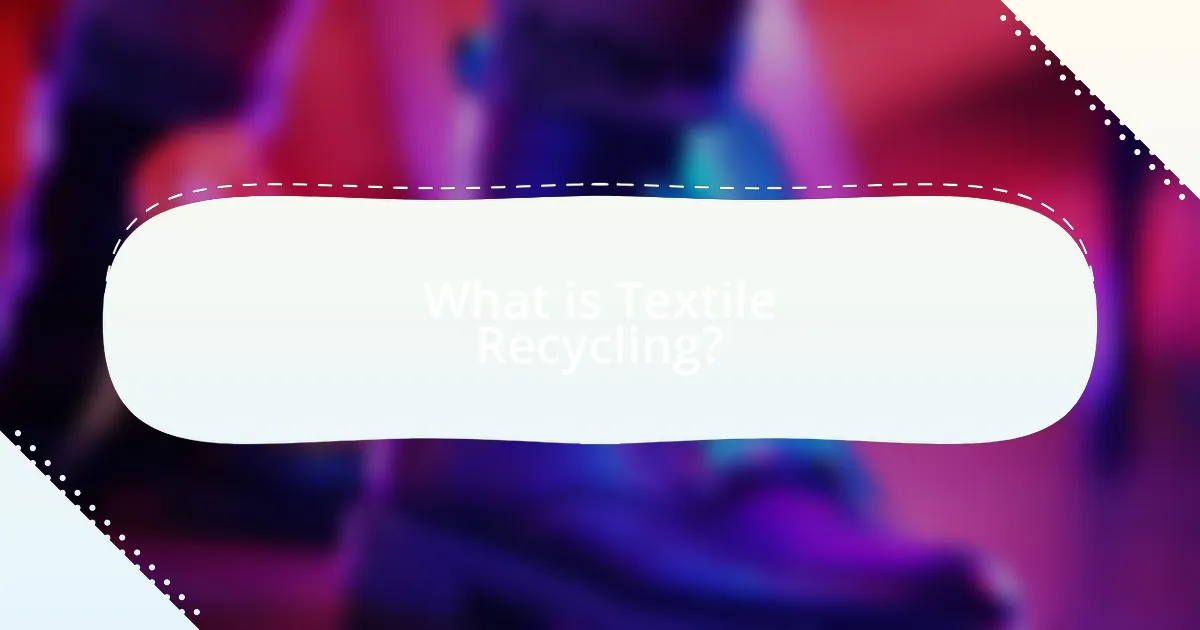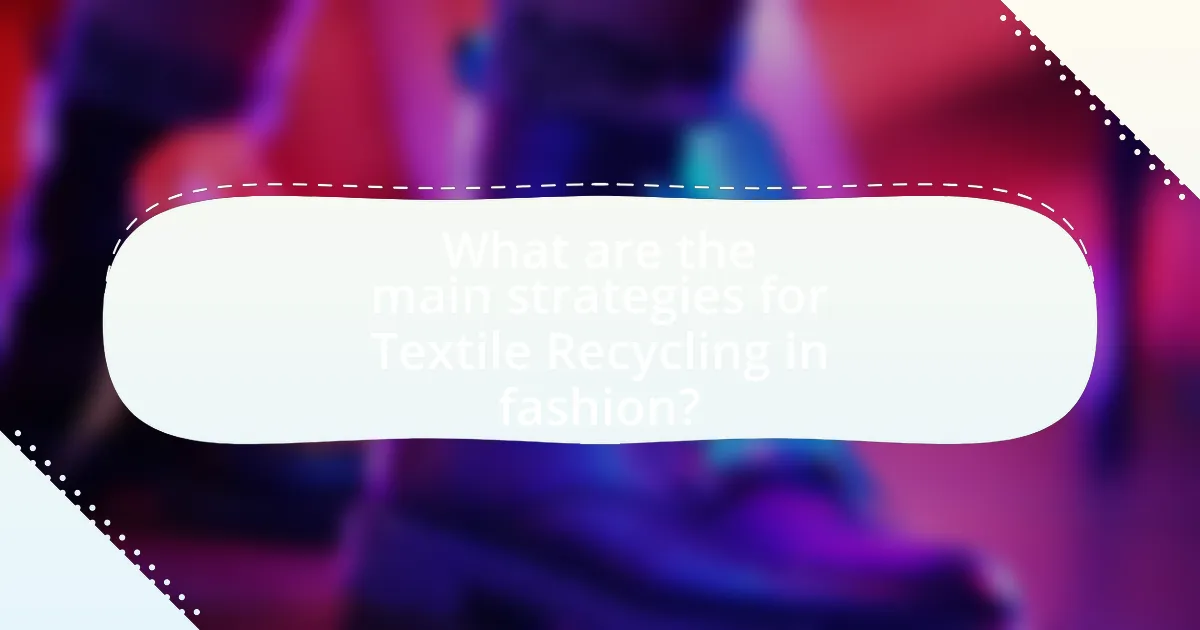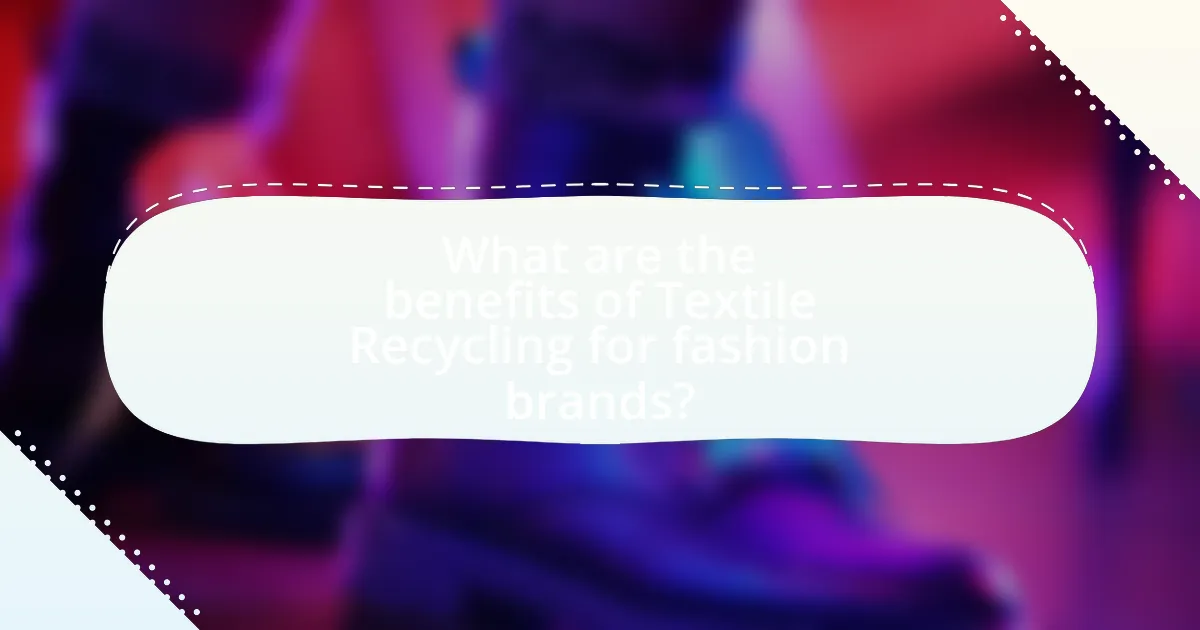Textile recycling is the process of recovering and reprocessing used textiles to create new products, significantly reducing waste and conserving resources. This article explores the importance of textile recycling in promoting sustainable fashion practices, detailing key processes such as collection, sorting, shredding, and reprocessing. It highlights the environmental benefits, including reduced greenhouse gas emissions and water conservation, while addressing the challenges brands face in implementing effective recycling initiatives. Additionally, the article discusses the role of consumer participation, technological advancements, and successful examples from leading brands, emphasizing the need for collaboration and innovation in the textile recycling sector.

What is Textile Recycling?
Textile recycling is the process of recovering and reprocessing used textiles to create new products, thereby reducing waste and conserving resources. This process involves collecting discarded clothing and fabric, sorting them by material type, and then transforming them into new fibers or products, which can significantly decrease the environmental impact associated with textile production. According to the Environmental Protection Agency, recycling one ton of textiles can save approximately 20,000 gallons of water and reduce greenhouse gas emissions by 3,000 pounds, highlighting the ecological benefits of textile recycling.
How does Textile Recycling contribute to sustainable fashion?
Textile recycling significantly contributes to sustainable fashion by reducing waste and conserving resources. By recycling textiles, the fashion industry can divert millions of tons of clothing from landfills each year; for instance, in the United States alone, approximately 11.3 million tons of textile waste were generated in 2018, according to the Environmental Protection Agency. This process not only minimizes the environmental impact associated with textile production but also decreases the demand for new raw materials, such as cotton and polyester, which require substantial water and energy to produce. Furthermore, recycling textiles can lead to the creation of new products, thereby promoting a circular economy within the fashion industry.
What are the key processes involved in Textile Recycling?
The key processes involved in textile recycling include collection, sorting, shredding, and reprocessing. Collection involves gathering discarded textiles from various sources such as consumers, retailers, and recycling centers. Sorting is the next step, where textiles are categorized based on material type, quality, and condition, which is crucial for determining the appropriate recycling method. Shredding follows, where sorted textiles are mechanically broken down into smaller pieces to facilitate further processing. Finally, reprocessing transforms the shredded materials into new fibers or products, which can be used to create new textiles or other items, thereby reducing waste and conserving resources. According to the Ellen MacArthur Foundation, recycling textiles can significantly reduce the environmental impact of fashion by minimizing landfill waste and lowering the demand for virgin materials.
How does Textile Recycling reduce waste in the fashion industry?
Textile recycling significantly reduces waste in the fashion industry by repurposing discarded clothing and fabrics into new products, thereby minimizing the volume of textiles sent to landfills. In 2018, the Environmental Protection Agency reported that approximately 11.3 million tons of textile waste were generated in the United States alone, highlighting the urgent need for effective recycling solutions. By recycling textiles, the industry can divert a substantial portion of this waste, reducing environmental impact and conserving resources. For instance, recycling one ton of textiles can save 20,000 gallons of water and reduce greenhouse gas emissions by 3,000 pounds, demonstrating the tangible benefits of textile recycling in promoting sustainability within the fashion sector.
Why is Textile Recycling important for the environment?
Textile recycling is important for the environment because it significantly reduces waste and conserves resources. By recycling textiles, approximately 92 million tons of waste are prevented from entering landfills each year, which helps mitigate the environmental impact of textile production and disposal. Additionally, recycling textiles saves water and energy; for instance, producing recycled fibers uses 70% less energy compared to virgin fibers. This process also decreases greenhouse gas emissions, contributing to climate change mitigation. Overall, textile recycling plays a crucial role in promoting sustainability within the fashion industry.
What environmental impacts does the fashion industry have?
The fashion industry has significant environmental impacts, primarily through resource consumption, pollution, and waste generation. It is responsible for approximately 10% of global carbon emissions, largely due to energy-intensive production processes and transportation. Additionally, the industry contributes to water pollution, with textile dyeing and finishing processes releasing harmful chemicals into waterways, affecting aquatic ecosystems. The production of clothing also requires vast amounts of water; for instance, producing a single cotton t-shirt can consume around 2,700 liters of water. Furthermore, the fast fashion model leads to excessive waste, with an estimated 92 million tons of textile waste generated annually, much of which ends up in landfills. These factors collectively highlight the urgent need for sustainable practices, such as textile recycling, to mitigate the environmental footprint of the fashion industry.
How does Textile Recycling mitigate these impacts?
Textile recycling mitigates environmental impacts by reducing waste in landfills and conserving natural resources. By recycling textiles, approximately 92 million tons of waste generated by the fashion industry annually can be diverted from landfills, significantly decreasing greenhouse gas emissions associated with decomposition. Additionally, recycling textiles conserves water and energy; for instance, producing recycled fibers uses 70% less water compared to virgin fiber production. This process also minimizes the need for new raw materials, thereby preserving ecosystems and reducing the carbon footprint associated with textile manufacturing.

What are the main strategies for Textile Recycling in fashion?
The main strategies for textile recycling in fashion include collection and sorting, mechanical recycling, chemical recycling, and upcycling. Collection and sorting involve gathering used textiles and categorizing them based on material type and condition, which is essential for effective recycling. Mechanical recycling processes, such as shredding and re-spinning, convert textiles into new fibers, while chemical recycling breaks down fibers into their original monomers for reuse. Upcycling transforms old garments into new products, extending their lifecycle and reducing waste. According to the Ellen MacArthur Foundation, implementing these strategies can significantly reduce the environmental impact of the fashion industry, as textiles account for a substantial portion of global waste.
How can brands implement effective Textile Recycling practices?
Brands can implement effective textile recycling practices by establishing take-back programs that encourage consumers to return used garments for recycling. These programs can significantly reduce textile waste; for instance, the Ellen MacArthur Foundation reports that only 1% of clothing is recycled into new garments, highlighting the need for improved recycling initiatives. Additionally, brands can collaborate with recycling facilities to ensure that collected textiles are processed efficiently, and they can invest in technology that enhances the recycling process, such as chemical recycling methods that can break down fibers into their original components. By adopting these strategies, brands can contribute to a circular economy and minimize their environmental impact.
What role does consumer participation play in Textile Recycling?
Consumer participation is crucial in textile recycling as it directly influences the volume and quality of materials collected for recycling. Engaged consumers contribute by donating, recycling, or repurposing their textiles, which enhances the overall effectiveness of recycling programs. According to a report by the Ellen MacArthur Foundation, increased consumer awareness and participation can lead to a significant reduction in textile waste, with estimates suggesting that up to 95% of textiles can be recycled or reused. This active involvement not only supports sustainable fashion practices but also fosters a circular economy, where resources are kept in use for as long as possible.
How can technology enhance Textile Recycling efforts?
Technology can enhance textile recycling efforts by improving sorting, processing, and tracking of materials. Advanced technologies such as artificial intelligence and machine learning enable more accurate sorting of textiles by fiber type and color, which increases the efficiency of recycling processes. For instance, automated sorting systems can process thousands of garments per hour, significantly reducing labor costs and time. Additionally, innovations like chemical recycling technologies allow for the breakdown of textiles into their original fibers, enabling the creation of new fabrics from recycled materials. According to a report by the Ellen MacArthur Foundation, implementing these technologies could help divert 92 million tons of textile waste from landfills by 2030, demonstrating their potential impact on sustainable fashion practices.
What challenges do brands face in Textile Recycling?
Brands face several challenges in textile recycling, primarily including the complexity of sorting materials, the lack of infrastructure, and consumer awareness. The sorting process is complicated due to the diverse range of fabrics and blends used in clothing, which can hinder effective recycling. Additionally, many regions lack the necessary infrastructure to support large-scale textile recycling, limiting brands’ ability to recycle effectively. Furthermore, consumer awareness about recycling options and the importance of sustainable practices remains low, which affects the volume of textiles collected for recycling. According to a report by the Ellen MacArthur Foundation, only 1% of textiles are recycled into new garments, highlighting the significant barriers brands encounter in promoting effective textile recycling.
How do economic factors influence Textile Recycling initiatives?
Economic factors significantly influence textile recycling initiatives by determining the financial viability and operational efficiency of recycling processes. For instance, the cost of raw materials directly impacts the demand for recycled textiles; when virgin materials are expensive, the incentive to recycle increases as recycled fibers can be a cheaper alternative. Additionally, government policies and subsidies aimed at promoting sustainable practices can enhance funding for recycling programs, making them more attractive to businesses. According to a report by the Ellen MacArthur Foundation, the global fashion industry could save $192 billion annually by adopting circular economy practices, including textile recycling, which underscores the economic benefits of such initiatives.
What are the logistical challenges in collecting and processing textiles?
The logistical challenges in collecting and processing textiles include transportation inefficiencies, sorting complexities, and contamination issues. Transportation inefficiencies arise from the need to collect textiles from various locations, which can lead to increased costs and time delays. Sorting complexities occur due to the diverse types of textiles, requiring specialized knowledge and equipment to separate materials effectively. Contamination issues arise when non-textile items are mixed with textiles, complicating the recycling process and reducing the quality of the recycled material. These challenges hinder the efficiency and effectiveness of textile recycling efforts, impacting the overall sustainability of fashion practices.

What are the benefits of Textile Recycling for fashion brands?
Textile recycling offers significant benefits for fashion brands, including reduced environmental impact, cost savings, and enhanced brand reputation. By recycling textiles, brands can decrease the volume of waste sent to landfills, which contributes to a more sustainable fashion industry. According to the Ellen MacArthur Foundation, the fashion industry is responsible for 92 million tons of waste annually, and recycling can mitigate this issue. Additionally, recycling can lower production costs by providing a source of raw materials, as recycled fibers often cost less than virgin materials. Furthermore, brands that engage in sustainable practices, such as textile recycling, can improve their public image and attract environmentally conscious consumers, leading to increased customer loyalty and sales.
How does Textile Recycling improve brand reputation?
Textile recycling improves brand reputation by demonstrating a commitment to sustainability and environmental responsibility. Brands that engage in textile recycling can enhance their public image, as consumers increasingly prefer companies that prioritize eco-friendly practices. According to a 2021 survey by McKinsey, 66% of consumers are willing to pay more for sustainable brands, indicating that sustainable practices, such as recycling, can lead to increased customer loyalty and trust. Furthermore, brands that adopt textile recycling can differentiate themselves in a competitive market, attracting environmentally conscious consumers and fostering positive brand associations.
What are the financial benefits of adopting Textile Recycling?
Adopting textile recycling provides significant financial benefits, including cost savings on raw materials and waste disposal. By recycling textiles, companies can reduce their reliance on virgin materials, which can be expensive due to fluctuating market prices; for instance, the global cotton price can vary significantly, impacting production costs. Additionally, recycling textiles minimizes landfill fees and associated environmental compliance costs, as waste management can be a substantial expense for businesses. According to a report by the Ellen MacArthur Foundation, transitioning to a circular economy in fashion could generate $560 billion in economic benefits by 2030, highlighting the potential for substantial financial gains through sustainable practices like textile recycling.
How can Textile Recycling lead to innovation in product design?
Textile recycling can lead to innovation in product design by providing designers with new materials that have unique properties and characteristics. This process allows for the creation of products that are not only sustainable but also incorporate novel textures, colors, and functionalities derived from recycled fibers. For instance, brands like Patagonia and Eileen Fisher have successfully integrated recycled materials into their collections, demonstrating that recycled textiles can enhance aesthetic appeal and performance. Furthermore, the use of recycled textiles encourages designers to rethink traditional design processes, fostering creativity and the development of new techniques that prioritize sustainability.
What are some successful examples of Textile Recycling in the industry?
Successful examples of textile recycling in the industry include H&M’s Garment Collecting Initiative, which has recycled over 30,000 tons of textiles since its launch in 2013, and Patagonia’s Worn Wear program, which encourages customers to repair and recycle their clothing, resulting in significant reductions in waste. Additionally, the company Renewcell has developed a process to turn textile waste into high-quality pulp for new fabrics, demonstrating a closed-loop system in textile production. These initiatives highlight effective strategies for reducing textile waste and promoting sustainability in fashion.
Which brands are leading the way in Textile Recycling initiatives?
Patagonia, H&M, and Nike are leading the way in textile recycling initiatives. Patagonia has implemented a program called Worn Wear, which encourages customers to repair, reuse, and recycle their clothing, significantly reducing textile waste. H&M has launched a garment collecting initiative, allowing customers to drop off used clothes for recycling, with the goal of using 100% recycled or sustainably sourced materials by 2030. Nike’s Move to Zero campaign focuses on reducing waste and promoting circularity, including their Reuse-A-Shoe program, which recycles old shoes into new products. These brands exemplify effective strategies in textile recycling, contributing to sustainable fashion practices.
What lessons can be learned from successful Textile Recycling programs?
Successful textile recycling programs demonstrate the importance of community engagement and education in promoting sustainable practices. These programs often involve local stakeholders, which fosters a sense of ownership and responsibility towards recycling efforts. For instance, the H&M Conscious Foundation’s initiative in Sweden has shown that educating consumers about the benefits of recycling can significantly increase participation rates. Additionally, successful programs emphasize the need for efficient collection and sorting systems, as seen in the case of the I:CO program, which has effectively partnered with retailers to streamline textile collection. These systems not only enhance recycling rates but also ensure that materials are processed effectively, maximizing their reuse potential. Furthermore, successful programs often incorporate innovative technologies for recycling, such as chemical recycling methods that can break down textiles into their original fibers, thereby expanding the range of materials that can be recycled. Overall, the lessons learned highlight the critical role of collaboration, education, and technology in advancing textile recycling initiatives.
What practical steps can consumers take to support Textile Recycling?
Consumers can support textile recycling by actively participating in clothing donation programs and utilizing textile recycling bins. By donating unwanted clothing to organizations like Goodwill or the Salvation Army, consumers ensure that usable items are reused, reducing waste. Additionally, many municipalities provide textile recycling bins specifically for non-wearable items, which are then processed into new materials. According to the Environmental Protection Agency, approximately 92 million tons of textile waste is generated annually in the U.S., highlighting the importance of recycling efforts. Engaging in these practices not only diverts waste from landfills but also promotes a circular economy in the fashion industry.
How can consumers effectively recycle their old textiles?
Consumers can effectively recycle their old textiles by utilizing local recycling programs, donating to charities, or participating in textile take-back initiatives offered by retailers. Local recycling programs often accept textiles and ensure they are processed appropriately, while donating to charities allows for reuse and supports community needs. Retailers like H&M and Patagonia have established take-back programs that encourage consumers to return used clothing for recycling or repurposing, thus reducing landfill waste. According to the Environmental Protection Agency, recycling textiles can divert approximately 2.5 billion pounds of clothing from landfills annually, highlighting the significant impact of these recycling methods.
What resources are available for consumers interested in Textile Recycling?
Consumers interested in textile recycling can access various resources, including local recycling programs, nonprofit organizations, and online platforms. Local recycling programs often provide drop-off locations for unwanted textiles, while nonprofit organizations like Goodwill and the Salvation Army accept donations of clothing and textiles for reuse or recycling. Additionally, online platforms such as Earth911 and RecycleNation offer searchable databases to locate textile recycling facilities based on zip codes. These resources facilitate responsible disposal and promote sustainable practices in the fashion industry.

Leave a Reply